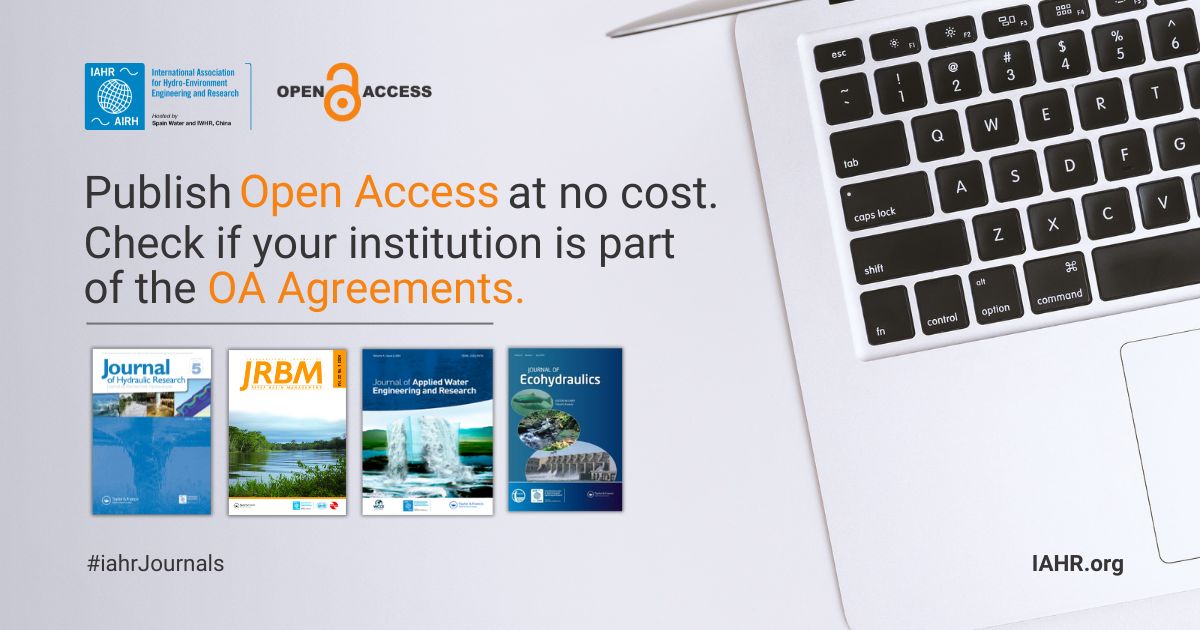International Journal of River Basin Management (JRBM) | Vol. 23. Issue 1, 2025
 The Journal of River Basin Management (JRBM) plays a specific role in promoting a cross-sectorial approach encompassing all aspects of river and floodplain management, with a truly global perspective. The Journal is a response by the scientific and professional community to the World Water Vision and calls for an integrated approach to water resources management.
The Journal of River Basin Management (JRBM) plays a specific role in promoting a cross-sectorial approach encompassing all aspects of river and floodplain management, with a truly global perspective. The Journal is a response by the scientific and professional community to the World Water Vision and calls for an integrated approach to water resources management.
IAHR members can access the latest issue online for FREE through the IAHR website. Watch the tutorial.
Non IAHR members must access through Taylor and Francis website.
Overview
The new year of the International Journal of River Basin Management starts with a new and intriguing collection of manuscripts. Issue 1 of JRBM Volume 23 reports on a variety of topics connected to river basin management, spanning from conflict management and risk management to flood mapping and water quality.
A few papers collected in this Issue investigated the role of precipitation forecasts in generating extreme conditions, such as the ones observed during the monsoon season in India. Forecasting was analysed using multiple approaches, which can also be extended to other fields, as demonstrated in the works presented here. Moving from rain, other papers addressed flood risk mapping in rivers, as well as the role of groundwater in water resources at the basin scale. In addition to manuscripts focusing on engineering and physical aspects, JRBM Issue 1(23) proposes also insights on conflict and risk management under hydrological stress, a hot topic in light of climate change and water-driven human relocation.
From this short overview, one can see that all articles collected here are worth reading, as they report and discuss the actual state-of-art in the management of water systems from a variety of viewpoints, showing both knowledge gaps and solutions that can be of interest worldwide.
Articles
Flood susceptibility mapping using fuzzy analytical hierarchy process for Cedar Rapids, Iowa
Beyza Atiye Cikmaz, Enes Yildirim and Ibrahim Demir
Pages: 1-13 | DOI: 10.1080/15715124.2023.2216936A process-based hydrological model for continuous multi-year simulations of large-scale watersheds
Marcela Politano, Antonio Arenas and Larry Weber
Pages: 15-28 | DOI: 10.1080/15715124.2023.2216937Post-processing quantitative precipitation forecasts using the seasonally coherent calibration model
Nibedita Samal, R. Ashwin, Qichun Yang, Ankit Singh, Sanjeev Kumar Jha and Q. J. Wang
Pages: 29-43 | DOI: 10.1080/15715124.2023.2218094Colorado River Basin: conflict management under hydrologic stress and institutional gridlock
Neil S. Grigg
Pages: 45-53 | DOI: 10.1080/15715124.2023.2229802Development of a watershed health assessment framework integrating ecological, social, cultural, economic and policy attributes
Shella I. Talampas, Sangam Shrestha, S. Mohanasundaram and Ho Huu Loc
Pages: 55-69 | DOI: 10.1080/15715124.2023.2242830Streamflow prediction in ungauged basins located within data-scarce areas using XGBoost: role of feature engineering and explainability
M. H. Alipour
Pages: 71-92 | DOI: 10.1080/15715124.2023.2245809Assessment of river response to water abstractions in the Weyib Watershed, Ethiopia
Mesfin Reta Aredo, Tarun Kumar Lohani and Abdella Kemal Mohammed
Pages: 93-104 | DOI: 10.1080/15715124.2023.2248488Risk management and components’ coordination assessment in the design of a composite riverine flood defence system
Masoume Behrouz and Saeed Alimohammadi
Pages: 105-121 | DOI: 10.1080/15715124.2023.2249436Fuzzy inference system for environmental vulnerability assessment of protected areas: a case study of the Itupararanga environmental protection area in southeastern Brazil
Pedro Henrique de Godoy Fernandes, Tatiana Acácio da Silva, Miqueias Lima Duarte, Jackson de Sousa and Francisco Antônio Dupas
Pages: 123-138 | DOI: 10.1080/15715124.2023.2260361Identifying groundwater prospect zones through earth observation techniques in Bilate watershed, Rift Valley Lakes Basin, Ethiopia
Demisachew Yilma, Samuel Dagalo Hatiye, Behailu Hussien and Karuturi Venkata Suryabhagavan
Pages: 139-157 | DOI: 10.1080/15715124.2023.2264268Towards the selection of a longer record of quantitative precipitation forecast dataset from TIGGE ensembles for India during the monsoon season
Ankit Singh, Akshay Singhal, R. Ashwin, Nibedita Samal, Ripunjay Pandey and Sanjeev Kumar Jha
Pages: 159-181 | DOI: 10.1080/15715124.2023.2270971Sequential riparian vegetation alteration in Japanese river landscapes
Takashi Asaeda, Diego García de Jalón, Matthew O’Hare and Mizanur Rahman
Pages: 183-195 | DOI: 10.1080/15715124.2023.2273843

